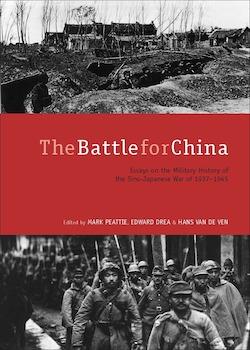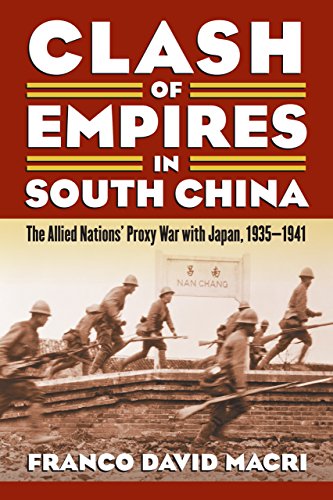‘The Battle for China’ and ‘Clash of Empires in South China’

The Battle for China: Essays on the Military History of the Sino-Japanese War of 1937-45
By Mark Peattie, Edward Drea & Hans van de Ven (eds)
Stanford University Press, 2011,
614 pages, 11 illustrations, 14 maps
ISBN: 9780804762069
Clash of Empires in South China: The Allied Nations’ Proxy War with Japan, 1935-41
By Franco David Macri
University of Kansas Press
2012,465 pages
ISBN-10: 0700618775
Reviews by Ian Nish
These two encyclopaedic works merit a more detailed review than can be given here. They complement each other but are different in their approach. Professor Peattie and his associates assembled about twenty experts on the war of 1937-45 in order to provide “a military history of the Sino-Japanese war based on Japanese, Chinese and Western sources [which] does not exist in English.” To remedy this, they managed to attract seven Japanese and seven Chinese specialists who participated in a ‘scholarly dialogue’ on this broad and controversial topic and have contributed essays to this excellent conference volume. Apart from expert analyses of the Chinese and Japanese armies in 1937, the studies concentrate mainly on the war in the north and central belt of China, where Chinese industry and population were larger and most of the major campaigns were conducted. The volume takes the story down to the Ichigo offensive [一号作戦] in the south in 1944 – the largest military operation in the history of the Japanese army, involving half a million troops.
Professor Macri’s is a single-author work, dealing mainly with Japan’s campaigns in South China between 1939 and 1941 and ending with the Japanese capture of Hong Kong. While it is primarily a military history, Macri reminds us of the international dimension, namely that these campaigns took place against the backdrop of a world war, or rather a European war, in which the allies were deliberately giving priority to the western front. From December 1941 the allies were opposed to Japan but were not prepared to make expeditions to assist China in her resistance. Thus Professor Macri would argue that China fought a proxy war against Japan on behalf of Britain and the United States.
After Japan’s invasion of China in 1937, her armies had remarkable successes, culminating in the capture of China’s headquarters at Hankow on the Yangtze river and then Canton, the major city of the south, in October 1938. The Chinese Nationalist government moved its capital to Chongqing in the remote west but there were doubts whether it could survive Japan’s sustained air attacks. Japan knew that her armies were superior to China’s and had originally assumed that the war would be a limited regional conflict with a favourable result for Japan. But she encountered unexpectedly strong resistance. In a telling simile, the authors observe that “by the end of 1938 Japanese and Chinese military forces [were] like two exhausted wrestlers, holding each other in check, each seeking some alternative thrust… to weaken his grip (Peattie, p.233).”
A war of attrition resulted. Because of frustration and the high cost of keeping a fighting force in the field, Japan became desperate to end, or shorten, the China war by way of some political settlement. She blamed France and Britain for allowing their ports and river systems (Hanoi, Rangoon, Hong Kong) for the transit of commodities through to Chinese cities. In particular, supplies of munitions to the Chinese armies regularly passed through these ports, thus contributing to the China’s military resistance. When the Burma Road was temporarily closed and the Japanese took over northern Indochina from Vichy France in 1940, Hong Kong became even more important for the needs of China.
Macri carries the story through the campaigns south of the Yangtze River and concludes at the end of 1941 with the defence of Hong Kong and focuses on the sending of Canadian combat forces there in the fall. While this served in many ways as a deterrent to Japan, the writer believes that the decision to reinforce the colony was both unnecessary and ignoble. Contrary to the received wisdom that Canada agreed to take part in this as a loyal Dominion, he concludes that she was more inclined to follow the wishes of the US from November 1940 onwards. Nonetheless Macri reaches the optimistic conclusion that British/Canadian resistance in the south encouraged Chinese armies in their anti-Japanese struggle and contributed to Japan’s feelings of failure. The fall of Hong Kong is followed by the Guomindang army’s victory in the third battle of Changsha, the key strategic point on routes to the south. Macri records that this Chinese victory was a notable success in the global war since the fighting in Southeast Asia had seen many catastrophic allied defeats.
Both books make an interesting point for historians of Japan when they observe that on a number of occasions Japanese naval commanders in the China seas were more aggressive than their army counterparts. The southward strike on Hong Kong was to a large extent a naval affair and naval commanders were by 1941 dissatisfied that their endeavours had not been as successful as they had hoped and were correspondingly tough-minded. By contrast, the army commanders, doubtless aware of the guerrilla warfare being waged by the Chinese people, gave the impression of not being unreasonable to negotiate. Of course much depended on the personalities of the commanders concerned and the circumstances of the moment. While it is clearly unwise to generalize over such a large front and with such large forces involved, it is an unexpected conclusion and merits further examination.
There is consensus between these authors that China’s role in the war has been underestimated in the English language literature. Not only did many Chinese army units fight well, the three victories at the battles of Changsha being a testament to that, but the mere survival of the Nationalist government at Chongqing, despite intensive and persistent aerial bombing, made a real contribution to the anti-Japanese cause. And the Nationalist and communist guerrilla groups held at bay many Japanese divisions which might otherwise have been transferred to other trouble spots.
These splendid studies supply the evidence for a reinterpretation of the Asia-Pacific war of which the China war was the origin and later became the centrepiece. They also have a global message for today: Do not assume that military victories will guarantee long-term political solutions!

